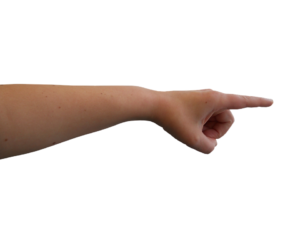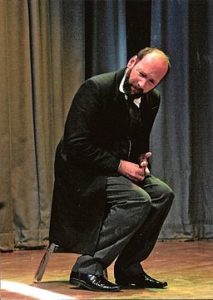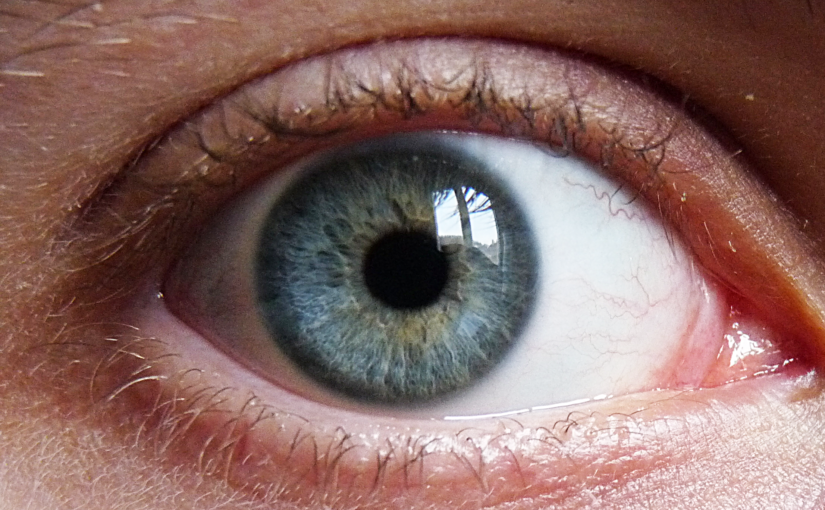I’m going to give you a new way to think about eye contact that helps you and your listeners feel more comfortable.
If you go by the most common advice you know you are supposed to make eye contact when speaking or presenting, but it can sometimes feel uncomfortable. Perhaps you’ve heard the 2 second rule, or the 3 second rule, or the 7 second rule, or maybe you follow the advice to look at the back wall.
Let’s simplify.
Uncomfortable Eyes
 Example 1: Imagine you are quietly reading a book on the sofa in the corner of your living room. I’m sitting on the other corner of the sofa, staring at you.
Example 1: Imagine you are quietly reading a book on the sofa in the corner of your living room. I’m sitting on the other corner of the sofa, staring at you.
Your eyes are fixed on the words of the book. My eyes are fixed on you. Am I looking at the book, or your forehead, or your hair, or your outfit? You don’t know.
How long before you feel uncomfortable?
Example 2: You’ve come to my class. Your sitting in an auditorium of 200 conference-goers listening to me tell a story on stage. In the middle of the story, we make eye contact.
I keep telling the story, but my gaze does not break from your face. My body moves around the stage, but my eyes never turn away from your direction.
How long before you feel uncomfortable?
It’s Not About Eye Contact
My point is not about how long it takes you to feel uncomfortable, my point is that you feel uncomfortable whether we have “eye contact” or not.

In example 1 you are not even looking at me, I’m looking at you. In example 2, we did make eye contact, but I’m willing to bet after a few seconds of my uncomfortable staring, you break that eye contact and look away.
Eye contact is not about eye contact
How you feel in both examples has little to do with eye contact. If you want to understand the appropriate way to handle eye contact here’s a new, simple way to think about it:
Point with your eyes
The Original Laser Pointer
 Before speakers had laser pointers, they had 2 eyes, 2 index fingers, and 2 elbows. The use of elbows as pointing devices never caught on. The eyes and fingers on the other hand, became interchangeable.
Before speakers had laser pointers, they had 2 eyes, 2 index fingers, and 2 elbows. The use of elbows as pointing devices never caught on. The eyes and fingers on the other hand, became interchangeable.
Let’s replace eye gaze with a pointing index finger:
Example 1: You’re sitting on the sofa reading a book and I’m pointing at you with my arm extended and my first finger aligned exactly with your face. You don’t know why I’m obsessed with you. That’s exactly what the prolonged eye contact felt like.
Example 2: You’re in my class and I point you out with a prolonged, accusing finger extension in front of 200 other audience members. It’s as if I’m inviting everyone else in the room to scrutinize your flaws. That’s exactly what the prolonged eye contact felt like.
You Point with Your Eyes
It’s very simple–wherever you point, people look.
 Example 1: You know that professor behind the lectern that stares at his notes the whole time. Just like you sitting on the couch reading a book, I can only point at you so long without making us both feel uncomfortable.
Example 1: You know that professor behind the lectern that stares at his notes the whole time. Just like you sitting on the couch reading a book, I can only point at you so long without making us both feel uncomfortable.
The professor’s eyes are pointing down at his notes, and that makes everyone in the audience want to stare down at their notes.
The more rapport you have with the audience the more they will want to look where you look. If you have no rapport it will just be too uncomfortable to stare, and they will look down anyway.
Example 2:
If the teacher looks at his notes, you’ll look at your notes.
If the teacher looks at the white board, you’ll look at the white board.
If the teacher looks at your eyes, you’ll look at his eyes.
But remember, the teacher isn’t just looking, he’s pointing.
If the speaker points his eyes at you too long, everybody else will look at you too.
If the speaker looks at the back wall, making no eye contact with the audience, he’s inviting the audience not to look at him.
I can’t tell you how often I go to a convention and see a speaker that’s so uptight that he or she doesn’t even realize the audience isn’t even paying attention. They are looking at phones, notes, and even the floor. But they are not looking at the speaker or the slide deck because the speaker is not pointing (with anything).
If the speaker makes eye contact with everybody, everybody is invited to look back, with rapt attention.
Simple answers
 If you think of eye contact as pointing a finger it will help you know the answer to every uncomfortable question:
If you think of eye contact as pointing a finger it will help you know the answer to every uncomfortable question:
Q: Should you look (point) at the whiteboard or flip chart? A: Look (point) where you want the audience to look.
Q: Should you look (point) at your slides? A: Look (point) where you want the audience to look.
Q: Should you look (point) at the picture behind you on stage or should you make eye contact (point) with the audience? A: Look (point) where you want the audience to look.
Q: How long should you keep eye contact with an individual? A: However long you would “point” at that individual.
Q: Should you look at the back wall over everyone’s heads? A: Only if you would point at the back wall over everyone’s heads.
You point with your eyes!
The Epiphany
For years, I would tell stories on stage. I’m not really an actor, so I wouldn’t be very dramatic about it, but to tell good stories I had learned to include lots of dialog and dramatic language.
 I always asked myself: When I’m telling a story with dialog, should I look at the audience, or should I look to the place on stage where the character I’m talking to would be standing?
I always asked myself: When I’m telling a story with dialog, should I look at the audience, or should I look to the place on stage where the character I’m talking to would be standing?
To solve the mystery, I made it a point to observe and study professional speakers. Guess what the professionals do?
Does the professional look at the audience, or does she look and the imaginary character on stage that she is talking to?
The answer is simple: it depends on where she wants the audience to look!
For more information on managing the stage, study the “Manage the theater” principle of my SpeechDeck presentation skills system.
When the professional speaker is making a point, she wants the audience to look at her eyes. Therefore she points at their eyes with hers. That’s eye contact.
When she’s telling a story, she wants the audience to imagine the story in their own minds. In that case she points with her eyes at imaginary locations on stage where the characters in the story would be placed if they were real. That’s NO eye contact.
In other words, don’t believe everything you hear. Eye contact is not about “eye contact.” It’s about “no contact.” You don’t CONTACT with your eyes, you POINT with your eyes.

